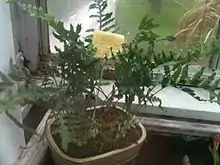Lecanopteris
Lecanopteris is a genus of ferns in the family Polypodiaceae, subfamily Microsoroideae, according to the Pteridophyte Phylogeny Group classification of 2016 (PPG I).[1] They have swollen hollow rhizomes that provide homes for symbiotic ants. All are epiphytic plants that naturally occur from Southeast Asia to New Guinea.[2][3] Several species are in commerce,[4] being grown as houseplants and greenhouse curiosities.
| Lecanopteris | |
|---|---|
 | |
| Lecanopteris curtisii | |
| Scientific classification | |
| Kingdom: | Plantae |
| Clade: | Tracheophytes |
| Class: | Polypodiopsida |
| Order: | Polypodiales |
| Suborder: | Polypodiineae |
| Family: | Polypodiaceae |
| Subfamily: | Microsoroideae |
| Genus: | Lecanopteris Reinw. |
| Species | |
Taxonomy
Phylogeny
The monophyletic genus Lecanopteris has been divided into two sub-genera, Lecanopteris and Myrmecopteris. All the species have rhizomes associated with ants. Subgenus Lecanopteris was monophyletic, and Myrmecopteris was paraphyletic.[2][3] A 2019 molecular phylogenetic study suggested that the genus was related to three other clades, treated as genera, related as shown in the following cladogram.[5]
| Lecanopteris s.l. |
| ||||||||||||||||||
As of February 2020, the Checklist of Ferns and Lycophytes of the World recognizes the segregate genera; other sources do not.
Species
As of February 2020, the Checklist of Ferns and Lycophytes of the World recognized the following species in Lecanopteris s.s.[6]
- Lecanopteris balgooyi Hennipman
- Lecanopteris carnosa (Reinw.) Blume
- Lecanopteris celebica Hennipman
- Lecanopteris crustacea Copel.
- Lecanopteris darnaedii Hennipman
- Lecanopteris deparioides (Ces.) Baker
- Lecanopteris holttumii Hennipman
- Lecanopteris luzonensis Hennipman
- Lecanopteris mirabilis Copel.
- Lecanopteris pumila Blume
- Lecanopteris sarcopus (Teijsm. & Binn.) Copel.
- Lecanopteris sinuosa (Wall. ex Hook.) Copel.
- Lecanopteris spinosa Jermy & T.Walker
References
- PPG I (2016), "A community-derived classification for extant lycophytes and ferns", Journal of Systematics and Evolution, 54 (6): 563–603, doi:10.1111/jse.12229, S2CID 39980610
- Gay, Honor (1993), "Rhizome structure and evolution in the ant‐associated epiphytic fern Lecanopteris Reinw. (Polypodiaceae)", Botanical Journal of the Linnean Society, 113 (2): 135–160, doi:10.1006/bojl.1993.1068
- Haufler, Christopher H.; Grammer, W. Andrew; Hennipman, E.; Ranker, Tom A.; Smith, Alan R. & Schneider, Harald (2003), "Systematics of the Ant-Fern Genus Lecanopteris (Polypodiaceae): Testing Phylogenetic Hypotheses with DNA Sequences", Systematic Botany, 28 (2): 217–227, JSTOR 3093992
- Stuart, Tom (2009), "Polypods exposed" (PDF), Bulletin of the American Fern Society, 36 (2 & 3): 9–25, retrieved 2020-06-23
- Testo, Weston L.; Field, Ashley R.; Sessa, Emily B. & Sundue, Michael (2019), "Phylogenetic and Morphological Analyses Support the Resurrection of Dendroconche and the Recognition of Two New Genera in Polypodiaceae Subfamily Microsoroideae" (PDF), Systematic Botany, 44 (4): 737–752, doi:10.1600/036364419X15650157948607, S2CID 208176686, retrieved 2020-02-11
- Hassler, Michael & Schmitt, Bernd (January 2020), "Lecanopteris", Checklist of Ferns and Lycophytes of the World, Version 8.20, retrieved 2020-02-10